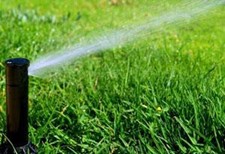How much water does my lawn need?
Your lawn requires roughly 1 to 1.5 inches of water weekly to encourage strong healthy roots . Deep, infrequent watering is better than light sprinklings . (In other words, there is no need to water every day, water less often for longer periods of time.) Depending on the soil type, most lawns require watering 1 to 2 times per week when combined with regular rainfall, and more frequently under drought conditions. Watering too much can cause just as many issues as not watering enough, especially in St. Augustine Grass. Over watering can promote many turf diseases and is typically the number one reason why lawns have problems. During the winter months, you can and should turn your irrigations systems off. We typically receive plenty of precipitation this time of year.
When should I water?
Early morning, around 5 AM is the best time to water the lawn. Mid-day watering during hot dry weather can waste water, since much of the moisture evaporates. Evening watering promotes the spread of many turf diseases.
How can I tell if my lawn is suffering from drought?
The symptoms of drought begin with a dark silvery tinged grass blade. At this point your foot prints become clearly visible. The grass does not bounce back when you walk on it. If action is not taken at this point, the grass plants will turn a straw color. If the lawn shows symptoms of drought, water immediately regardless of the time of day.

What happens to my lawn after long periods of drought?
Dormancy is one of the mechanisms nature has developed to help plants survive drought conditions. Summer dormancy occurs in a lawn when grasses are exposed to an extended period of heat and lack of moisture. This causes the lawn to temporarily stop growing. When the lawn becomes dormant the leaves and stems of the plants turn brown as the crowns and buds stop growing. The lawn appears to be dead or dying.
Will it recover?
Do not panic! When the weather changes and cooler temperatures arrive along with adequate moisture, the grass will usually begin to grow again. With proper care the lawn will return to a healthy state. It is important to remember that permanent damage can begin to occur if the lawn goes more than 4 weeks without adequate water. If you have trouble or lack the resources to water, water when you can. One quarter of the recommended water will keep the crowns of the grass alive until nature helps out.
What can I do?
The following practices will help to prevent or reduce the symptoms of dormancy from occurring;
· Avoid drought stress by watering early in the morning
· Deep, infrequent watering promotes a healthy root system that is better able to survive drought stress. Make sure your lawn is receiving roughly 1 inch of water each week.
· Keep the cutting height at 2.5 to 3.5 inches.
· Maintain a healthy lawn throughout the year with regular applications of fertilizer. A thick, healthy lawn will encourage a deep root system that will be able to store nutrients and water for use during drought periods.
If you have any questions or concerns or if you would like more information about proper watering practices, contact your local Weed Man ® professional. You can also visit our website at www.shreveport.weedman.com for more information.




